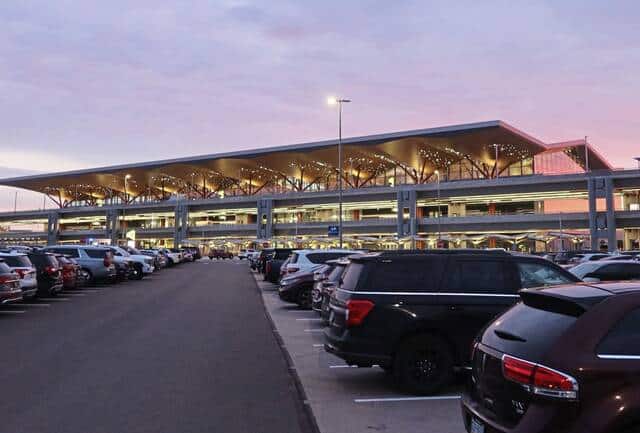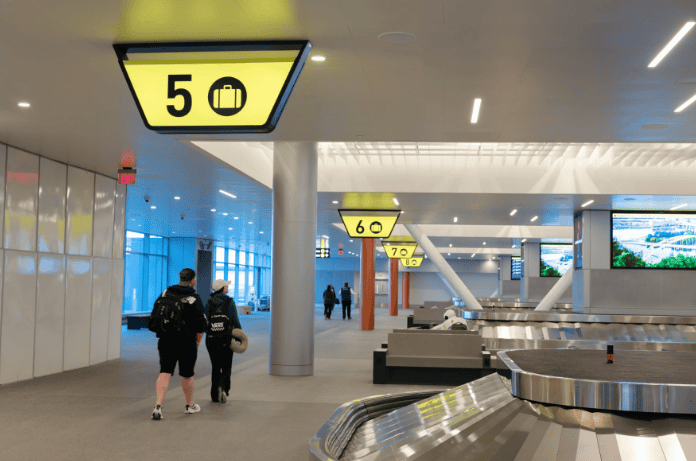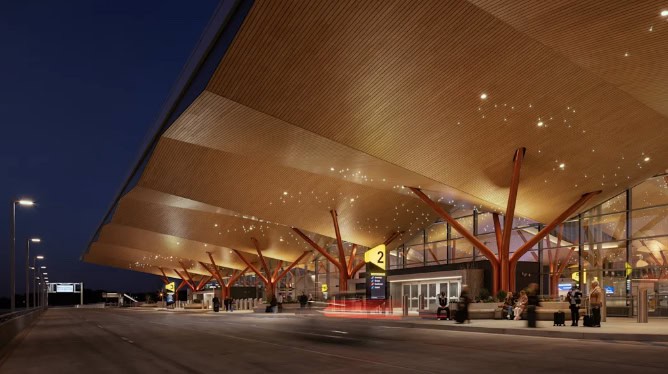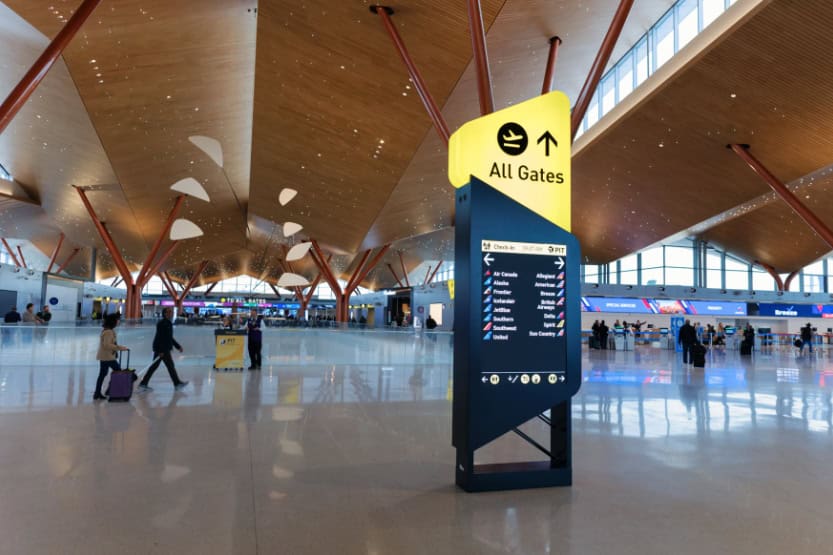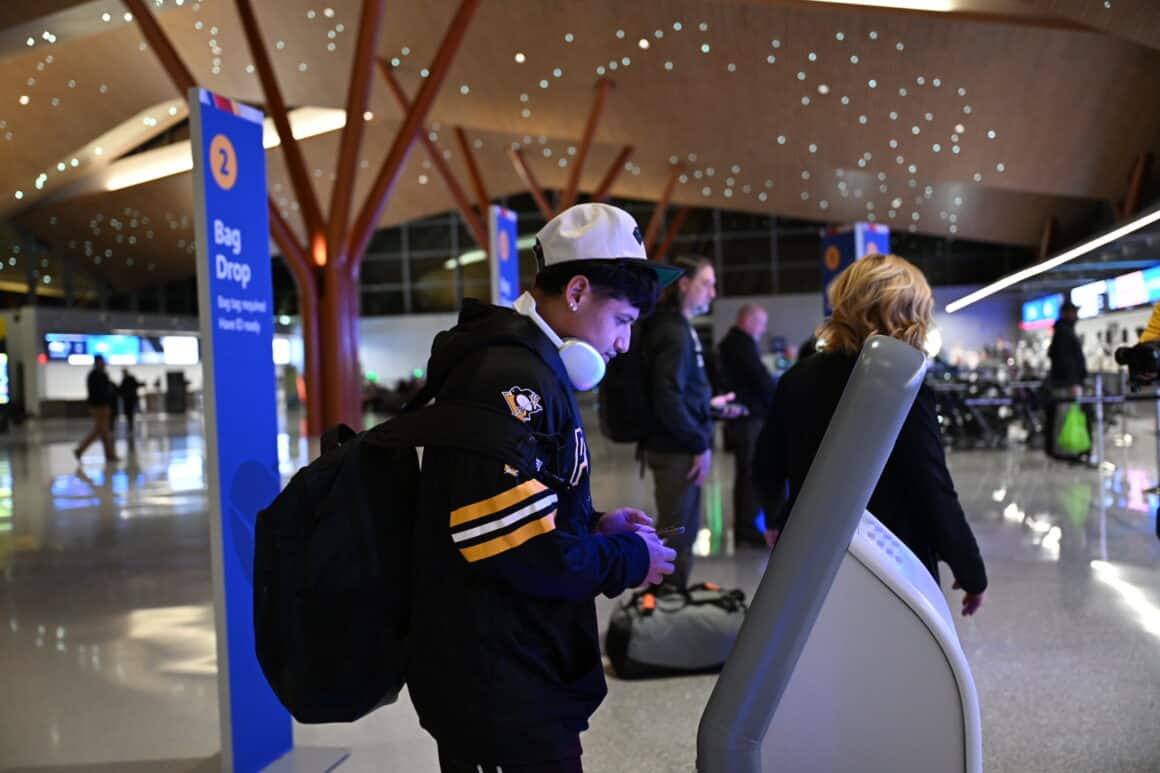Pittsburgh Airport has redefined its identity, moving beyond decades of USAir dominance.
The latest in a wave of modernization projects across American airports officially reached the finish line this week.
Early Tuesday, 18 November 2025, Pittsburgh International Airport (PIT) opened its new landside terminal to the public at 0200 local time. This debut followed almost ten years of planning, design, and construction. The new terminal replaces the former landside facility, which first opened in October 1992.

The first flight to land after the new terminal opened its doors was United Flight 794 from San Francisco (SFO), which landed at 0502 local.
Opening day went smoothly with no major issues. The Allegheny County Airport Authority expected around 20,000 passengers on the first day. Early enthusiasm was obvious. By 1100, the new 3,300-space parking garage and the 2,700-space surface lot were full. These lots nearly triple PIT’s previous parking capacity. They now feature space finder technology, improved signage, electric vehicle charging stations, and a snow melt system that keeps operations running during Pittsburgh winters.
For anyone who has flown from PIT in recent years (including your author, who has spent many cold mornings shivering uncontrollably after a long walk from my car to the heat of the terminal), the parking situation was often the most frustrating part of the experience. Long walks and long waits were common. Now, the redesigned parking areas sit significantly closer to the terminal entrance. Travelers can go from car to check-in and security in about five minutes.
The airport also removed the tram that once took passengers from landside to airside. The elimination of the system will save the airport authority approximately $4.5 million per year.

A Terminal Built for Today
A new pedestrian tunnel links the new landside terminal to the existing airside concourses. Designers drew inspiration from western Pennsylvania’s skies, weather, and terrain. Lighting in the tunnel mimics local atmospheric conditions. The tunnel’s shape mirrors Pittsburgh’s Fort Pitt Tunnel, which famously frames the downtown skyline for drivers entering the city.
To prepare for opening day, PIT held two large-scale “stress tests” with thousands of volunteer “travelers.” These trial runs allowed crews to fine-tune operations before the real crowd arrived on opening day.
The modernization project brings PIT firmly into the 21st century. The facility features a streamlined 12-lane security checkpoint, a much faster baggage claim, improved wayfinding, and a far more intuitive layout.
TSA officials expect the checkpoint to be one of the most efficient in the country.
All lanes are consolidated in one location, and the space features next-generation screening equipment, modern electronic displays, expanded recompose areas, and a large, open design that avoids the cramped feel of older checkpoints.
Several advanced systems are now active inside the checkpoint. Sixteen CAT 2 units compare real-time photos to ID images for identity verification. Eight automated screening lanes utilize larger bins, automatic return systems, and RFID tracking to efficiently process carry-ons. Computed Tomography scanners create detailed 3D images, letting travelers leave laptops, electronics, and small liquids in their bags.

The construction of Pittsburgh Airport’s new terminal cost approximately $1.7 billion. Travelers will find twenty new food and beverage options. The overhaul was overdue. The airport was originally built to support the giant USAir (then US Airways) hub of the late 1980s and 1990s. When US Airways de-hubbed Pittsburgh in 2004, passenger numbers collapsed. PIT, once a symbol of modernity, no longer fit the city’s and region’s needs. The PIT Terminal Modernization Project (TMP) was created to solve that.
The investment has coincided with a resurgence. Over the last decade, Pittsburgh International has added new carriers and new routes at a steady pace. The airport now offers service to 61 nonstop destinations, operated by 15 different airlines, compared to just 36 destinations and seven carriers ten years ago.
Of course, it goes without saying that PIT’s 170 daily flights today are a drop in the bucket compared to the more than 500 it boasted in the height of the US Airways hub days in the early 2000s. The TMP is responsible for right-sizing PIT and shedding the last vestiges of an airport designed for an airline, not a city.
A Design Rooted in Western Pennsylvania

The new terminal is filled with natural light and sweeping space. Its roofline is shaped to evoke the rolling hills of western Pennsylvania. Steel supports resemble tree trunks in a forest, and tezzarro flooring displays intricate leaf patterns. More than 4,000 ceiling lights create a starry night effect visible from both inside and outside the building.

Four landscaped outdoor courtyards offer travelers a surprising amount of open-air space. Two are open to the public on the landside portion of the terminal, and two more are behind security. Combined, they cover more than two acres, which is nearly the size of a small state park! (At roughly three acres, Pennsylvania’s Sand Bridge State Park holds the title for the smallest state park in the nation.) At least one terrace will remain accessible year-round, despite Pittsburgh’s often cold and snowy winters.
Wayfinding at the Pittsburgh Airport has been redesigned. Clear sight lines, distinct arrival and departure signs, high-contrast visuals, and well-placed electronic displays now guide passengers. Walking distances are shorter, and the layout is much more intuitive than before.
The airside terminal, which continues to serve as the home for PIT’s concourses and gates, has not been left behind. All gate areas and restrooms have been remodeled. Travelers will find upgraded seating with device chargers, new LED lighting, improved informational screens, modernized restrooms with art installations, a nursing room in each concourse, and adult changing facilities.
Check-in is now completely overhauled. Airline counters are near the entrance, on the same level as security. Electronic displays, accessible-height counters, and a simple layout help passengers move fast from curb to counter.
The official ribbon cutting for the project took place more than a month ago on 11 October, but Tuesday’s opening marks the true start of a new chapter for PIT.
Leadership Praises a New Beginning

PIT CEO Christina Cassotis noted that the building was always designed to be more than functional.
“The building design was always aspirational. It was meant and designed to work for everyone, for actual people who travel through and work in an airport,” she said. “But the building itself, if you look at it now, I think is actually inspirational. Being in this space feels good, and that is a pretty big statement for an airport today.”
Pennsylvania Governor Josh Shapiro echoed the sentiment. “Western Pennsylvania is growing, and it is no surprise that airlines are adding new flights,” he said, pointing to recent PIT expansions from American Airlines, JetBlue, Delta, and Southwest. “Passengers coming from and going to all of those destinations will have a better experience thanks to this new terminal.”
A New Pittsburgh Landmark

Pittsburgh International Airport’s landside terminal is more than a new building. It is a symbol of an airport and a region moving forward. Designed for real travelers rather than connecting traffic from a bygone hub era, the new PIT delivers speed, comfort, better screening, easier navigation, and a sense of place rooted in western Pennsylvania.
After decades defined by the rise and fall of a major airline hub, PIT finally has a terminal built for its future.
It is truly a new airport for a new Pittsburgh.

